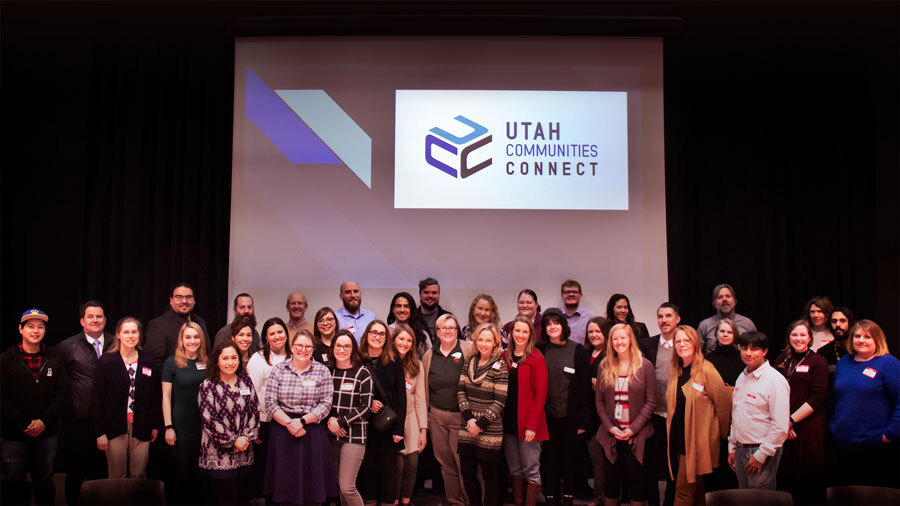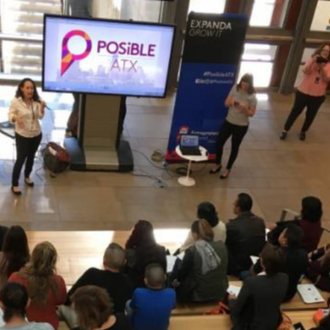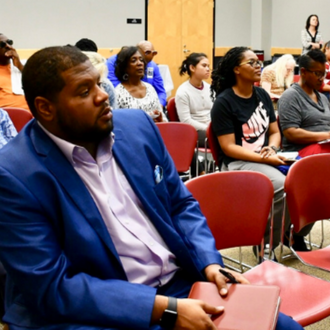Strategic Partnerships Are Key for Digital Inclusion
by Shauna Edson, Digital Inclusion Coordinator, Salt Lake City Public Library

Digital equity work, like all equity work, is complex. Digital equity demands different approaches for different folks, and creating a digitally equitable community requires an understanding of the myriad ways individuals interact and engage with the digital environment. Access to technologies, digital literacy levels and access to broadband have a direct correlation with social class, education levels and race. As we see the shift of financial, entertainment, health care, communications, education and social services to exclusively online platforms, digital literacy needs have also shifted from teaching “how-to” skills to facilitating curiosity, innovation, critical thinking and experimentation in the digital environment. Digital inclusion is the work that aims to foster digitally equitable communities, which seeks to improve lives and create positive societal impact. Libraries, as established and trusted anchor institutions, have become leaders in digital inclusion work.
I first became aware of digital inequities when I was taking undergraduate classes at the University of Utah. I didn’t have an internet connection in my apartment or a smartphone, and I quickly learned how much that complicated my education. To turn in assignments, access readings and do everything else students need to do online I had to go to a public computer lab. I was also a single parent at the time, and that meant I either had to pay for child care or bring my tweens with me to the computer lab, pay for parking and try to fit going to the lab in between my classes and the three part-time jobs I was juggling. I don’t know if you have any experience studying while trying to keep your kids entertained in a public space, but it didn’t work out well for me.
At the same time, I was teaching writing workshops at refugee organizations, jails, bookstores, senior centers and other community organizations along the Wasatch Front as the Diversity Writing Series coordinator for the SLCC Community Writing Center. When I started to collect submissions for the writing center’s annual publication, the sine cera, I noticed some folks submitted them online, while others mailed in paper submissions. So, I set up a time to pick up some submissions in person (these were often handwritten on paper). While facilitating workshops, I also noticed that I could only teach folks part of the process of writing a resume when the participants didn’t have access to a computer to format and send the resume via email or submit it to a website. While not everyone wants or needs a computer, access to the internet and the knowledge of how to use technologies, it became apparent that folks without access to information communication technologies were not able to fully accomplish the writing tasks they set out to accomplish. Traditional literacies and digital literacies formed a Venn Diagram.
Traditional literacies and digital literacies formed a Venn Diagram.
With these experiences in mind, I accepted the position as the full time NTEN Digital Inclusion Fellow at the Salt Lake City Public Library in July 2016. I had a one-year contract, a budget of $10,000 and an aim to increase access in the community to broadband service, devices and digital literacy education as well as develop the capacity of the organization. The plan was to recruit 20 volunteers and increase the capacity and number of existing digital literacy education programs and public computer labs in all the communities SLCPL serves, with an emphasis on neighborhoods most impacted by digital inequities.
I was not doing this work alone; I had a significant support network at SLCPL. I worked closely with Public Technology Training Manager Gwen Page and her Tech Access team, Adult Services Coordinator Tommy Hamby, Deputy Director Debbie Ehrman and Executive Director Peter Bromberg. Because digital equity is not a one-size-fits-all paradigm, I quickly learned it is essential to get to know the communities you serve at a micro-level. To do this, I reached out to branch staff as well as community organizations with a demonstrated history of reaching underrepresented community members. Strategic partnerships became essential to the success of the work I strived to accomplish.
After the yearlong fellowship ended, SLCPL hired me as the digital inclusion coordinator, and we have continued to foster a network of support for digital equity in the library - we now have a Community Access to Technology Team with library staff from throughout the system. At a system-wide level, the team strives to build knowledge, understanding and support for a digital equity strategy. We have experimented with pilot programs, learned from several failures and found some successes. Below are some of the strategies I have found to be beneficial for digital inclusion work at SLCPL.
Digital equity work requires gaining an understanding of what organizations and individuals are in your community, what their successes are and what limitations there are on the services they provide.
Five key components to creating a digital inclusion strategy in your library:
- Be part of the communities you serve. Relationships and trust are essential to understanding your community and advancing equity in all its forms. It requires going outside of our library doors and spending time in the spaces in which community members are shopping, socializing, learning and working. Be present. Listen. Talk to power library users and seek to understand what they love about the library, and other ways the library could support their goals. Invite community organizations and classes in for a personalized library tour and sign-up for cards. Understand who is not using the library and invite them to participate in creating new collections, services and/or programs to foster a sense of belonging in the space.
- Ask community members how they are using technology and find out what they want to do with it. At the beginning of my fellowship, I made digital literacy programming assumptions based on demographic and statistical data. I created beginning computer classes for a branch that had historically low internet connectivity rates in homes because I assumed this meant the community members didn’t have basic digital literacy skills. Nobody came. It turns out that folks were connected, not on PCs and laptops, but using apps and smartphones and tablets. This was a gap in the data; the community members wanted more advanced classes, and programs started filling up when we shifted the content.
- Create strategic partnerships. I love working with others, and if it were up to me I would want to partner with everybody. I have learned that librarians share that same commitment to teamwork. Digital equity work requires gaining an understanding of which organizations and individuals are in your community, what their successes are and what limitations there are on the services they provide. Libraries have specific assets and strengths, and recognizing the gaps that exist in the services offered in the community makes for great opportunities to develop collaborative partnerships. SLCPL works with community partners that serve individuals that face barriers to coming in to the library: senior centers, resource and rehabilitation centers, community schools, service providers for individuals experiencing homelessness and media centers.
- Form a coalition or alliance. In October 2017, several community organizations worked together to plan a kick-off event announcing Salt Lake City as a ConnectHome city. The event generated a lot of discussion and a desire for collaboration, networking and sharing of resources to advance digital equity. Utah Communities Connect was formed with SLCPL taking the lead. The alliance allows a space for partners to come together and work to address digital equity on a macro level. The work of the alliance has raised awareness of digital inclusion efforts and created momentum to support city policy, as well as state-wide digital equity efforts.
- Advocate for funding. As libraries take on more of the labor in providing access and helping folks interact with and use technology and engage in the digital environment, we need funding to support this critical work. High-level buy-in is key to addressing the hardware, software, staff training, new staff positions and space needs that all require financial support.
Libraries have specific assets and strengths, and recognizing the gaps that exist in the services offered in the community makes for great opportunities to develop collaborative partnerships.
As 21st-century knowledge and information communication technologies continue to expand, digital equity leads to better civic and cultural participation, economic growth and employment, health care, lifelong learning and access to essential services. Libraries have long been leaders in digital equity and digital inclusion, and provide programs, services and outreach to digitally serve our communities.
Libraries have a responsibility to continue to strive to:
- Understand those in our communities that lack access to technologies
- Work with community members and stakeholders to help create digitally equitable cities
- Seek out funding in the nonprofit and private sectors and leverage those resources with your partners to advance digital equity
Shauna Edson is the digital inclusion coordinator at the Salt Lake City Public Library. She leads the library’s digital inclusion initiative, the Tech League, and works with library staff and community partners to create long-term digital inclusion programming in the communities the library serves. Shauna is a contributing author to Tech For All: Moving Beyond the Digital Divide (2019), and has spoken nationally and internationally on digital equity, digital literacy and digital storytelling. She serves as the Chairwoman for Utah Communities Connect: Utah's Digital Alliance, an NDIA Fellow and an associate instructor at the University of Utah.

Learn more about Salt Lake City Library's digital leadership at the 2019 ULC Forum
This October 16-18, the 2019 ULC Forum: Preparing to Lead on AI + Digital Citizenship will convene our member community in Salt Lake City to engage in expert-led discussions and activities to elevate our shared understanding of the economic and social implications of emerging technologies.
Hosted by Salt Lake City Library and Salt Lake County Library, this important event will bring together leaders from major urban library systems across the U.S. and Canada. Together, we will map out how libraries can take ownership of their role at the forefront of the AI revolution, fostering and empowering digital-savvy citizens with services and tools that will strengthen democracy.
Related Articles

Finding the Right Partner Leads to Magic
Austin Public Library
Gain a perspective on Austin Public Library’s experience as part of the ULC Entrepreneurship Learning Cohort over the past eight months.
Learn More

Helping Small Businesses and Nonprofits Navigate the Pandemic in Greensboro
Greensboro Public Library
Discover how Greensboro Public Library developed a new COVID-19 Small Business & Nonprofit Resource Guide to offer local, state and federal resources to help small businesses and nonprofits navigate the pandemic.
